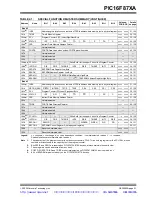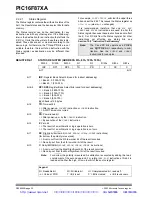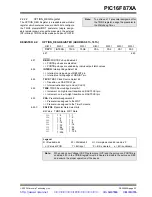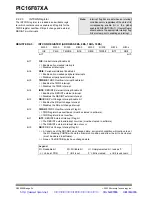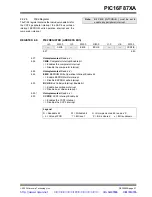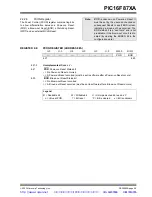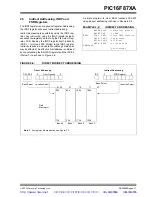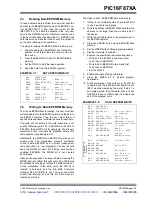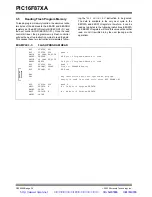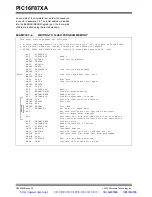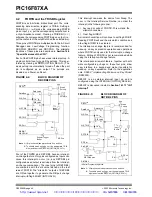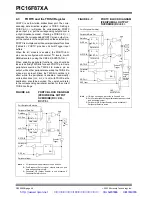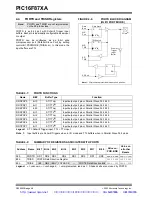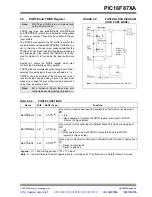
2003 Microchip Technology Inc.
DS39582B-page 35
PIC16F87XA
3.3
Reading Data EEPROM Memory
To read a data memory location, the user must write the
address to the EEADR register, clear the EEPGD con-
trol bit (EECON1<7>) and then set control bit RD
(EECON1<0>). The data is available in the very next
cycle in the EEDATA register; therefore, it can be read
in the next instruction (see Example 3-1). EEDATA will
hold this value until another read or until it is written to
by the user (during a write operation).
The steps to reading the EEPROM data memory are:
1.
Write the address to EEADR. Make sure that the
address is not larger than the memory size of
the device.
2.
Clear the EEPGD bit to point to EEPROM data
memory.
3.
Set the RD bit to start the read operation.
4.
Read the data from the EEDATA register.
EXAMPLE 3-1:
DATA EEPROM READ
3.4
Writing to Data EEPROM Memory
To write an EEPROM data location, the user must first
write the address to the EEADR register and the data to
the EEDATA register. Then the user must follow a
specific write sequence to initiate the write for each byte.
The write will not initiate if the write sequence is not
exactly followed (write 55h to EECON2, write AAh to
EECON2, then set WR bit) for each byte. We strongly
recommend that interrupts be disabled during this
code segment (see Example 3-2).
Additionally, the WREN bit in EECON1 must be set to
enable write. This mechanism prevents accidental
writes to data EEPROM due to errant (unexpected)
code execution (i.e., lost programs). The user should
keep the WREN bit clear at all times, except when
updating EEPROM. The WREN bit is not cleared
by hardware
After a write sequence has been initiated, clearing the
WREN bit will not affect this write cycle. The WR bit will
be inhibited from being set unless the WREN bit is set.
At the completion of the write cycle, the WR bit is
cleared in hardware and the EE Write Complete
Interrupt Flag bit (EEIF) is set. The user can either
enable this interrupt or poll this bit. EEIF must be
cleared by software.
The steps to write to EEPROM data memory are:
1.
If step 10 is not implemented, check the WR bit
to see if a write is in progress.
2.
Write the address to EEADR. Make sure that the
address is not larger than the memory size of
the device.
3.
Write the 8-bit data value to be programmed in
the EEDATA register.
4.
Clear the EEPGD bit to point to EEPROM data
memory.
5.
Set the WREN bit to enable program operations.
6.
Disable interrupts (if enabled).
7.
Execute the special five instruction sequence:
• Write 55h to EECON2 in two steps (first
to W, then to EECON2)
• Write AAh to EECON2 in two steps (first
to W, then to EECON2)
• Set the WR bit
8.
Enable interrupts (if using interrupts).
9.
Clear the WREN bit to disable program
operations.
10. At the completion of the write cycle, the WR bit
is cleared and the EEIF interrupt flag bit is set.
(EEIF must be cleared by firmware.) If step 1 is
not implemented, then firmware should check
for EEIF to be set, or WR to clear, to indicate the
end of the program cycle.
EXAMPLE 3-2:
DATA EEPROM WRITE
BSF
STATUS,RP1
;
BCF
STATUS,RP0
; Bank 2
MOVF
DATA_EE_ADDR,W ; Data Memory
MOVWF
EEADR
; Address to read
BSF
STATUS,RP0
; Bank 3
BCF
EECON1,EEPGD
; Point to Data
; memory
BSF
EECON1,RD
; EE Read
BCF
STATUS,RP0
; Bank 2
MOVF
EEDATA,W
; W = EEDATA
BSF
STATUS,RP1
;
BSF
STATUS,RP0
BTFSC
EECON1,WR
;Wait for write
GOTO
$-1
;to complete
BCF
STATUS,
RP0
;Bank 2
MOVF
DATA_EE_ADDR,W ;Data Memory
MOVWF
EEADR
;Address to write
MOVF
DATA_EE_DATA,W ;Data Memory Value
MOVWF
EEDATA
;to write
BSF
STATUS,RP0
;Bank 3
BCF
EECON1,EEPGD
;Point to DATA
;memory
BSF
EECON1,WREN
;Enable writes
BCF
INTCON,GIE
;Disable INTs.
MOVLW
55h
;
MOVWF
EECON2
;Write 55h
MOVLW
AAh
;
MOVWF
EECON2
;Write AAh
BSF
EECON1,WR
;Set WR bit to
;begin write
BSF
INTCON,GIE
;Enable INTs.
BCF
EECON1,WREN
;Disable writes
R
e
qui
red
S
e
q
uen
ce
http://www.xinpian.net
提供单片机解密、IC解密、芯片解密业务
010-62245566 13810019655

